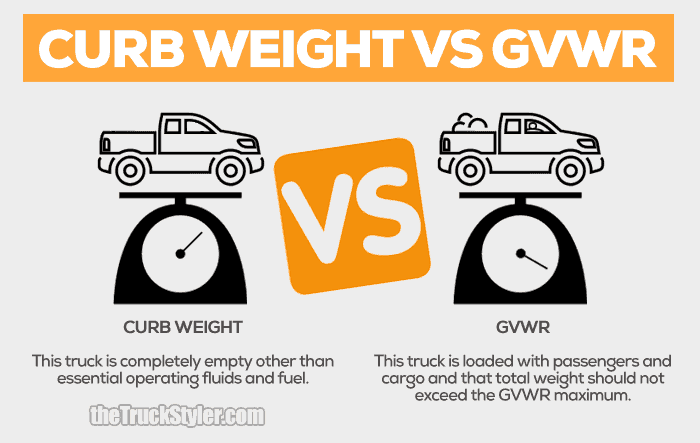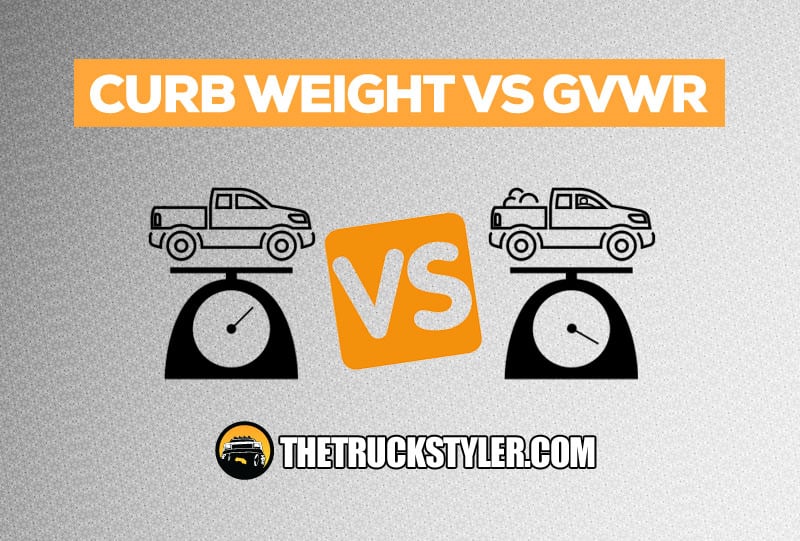It was around 5 year ago that I bought my first pickup. I’m not ashamed to admit that I had next to no knowledge of what all the different terms and phrases meant. However, my cousin did tell me that I needed to know about weights and capacities and how they were going to be very important. This was particularly the case as I was planning on using my truck for work, transporting some very heavy loads. It took me a little research to get it all straight in my mind, and here’s what I found.
To summarize, getting your weights wrong can be dangerous, and so it’s critical to know the difference between curb weight vs GVWR, but thankfully it is relatively simple and straight forward and you can read the differences below, as well as seeing this graphic I’ve created.
Curb Weight vs GVWR differences
Curb Weight:The weight of the truck or vehicle completely unmodified with standard equipment on board, with a full tank of fuel and other necessary operating fluids. There are no passengers or cargo and is simply how much it weighs if idle and empty at the side of a curb.
GVWR (Gross Vehicle Weight Rating):Slightly more complicated, this is the weight that the truck should never exceed in order to be driven safely. The GVWR weight includes everything loaded on including driver, passengers, and cargo, and importantly, also the weight of the truck itself.
And here’s that graphic that could help you visualize things better in order to understand what the difference between curb weight and GVWR is.

So that’s a very basic overview of curb weight vs GVWR.
But things can get more complicated, so only read on if you are going to be transporting goods from point A to point B in a truck or RV and want to stay safe and be on the right side of the law.
What Does GVW Mean?
Great question, and it’s a little bit different to GVWR, but actually helps explain GVWR a lot better.
GVW is the gross vehicle mass (or weight) and is how much the vehicle weighs with all its parts and load, including any passengers and cargo.
In simple terms, if you are getting ready to drive your truck or car somewhere, as soon as everyone is in it, plus anything else that you are carrying, then the weight it’s standing at is the GVW. Just imagine putting the whole thing and contents onto a massive set of scales. That’s the vehicle’s GVW.
How this relates to GVWR is also simple.
If your GVW exceeds the GVWR safety rating, then you’re in trouble.
To put that into a real-world example, let’s say your truck has a GVWR of 12,000 pounds, and the curb weight of the truck is 7,000 pounds, that means you’ve got 5,000 pounds to play with once it’s fully loaded.
Still not clear?
OK, so your truck weighs 7,000 pounds. The driver, passengers, and cargo then weighs in at 5,000 pounds. Add those together and you’ve reached a GVW of 12,000 pounds.
If your GVWR is less than that, you’re overloaded and potentially unsafe to drive.
Anything over that and you’ve exceeded your GVWR as stated by the manufacturer who has put your vehicle through extensive safety tests to come up with this rating figure.
Why the Difference Between Curb Weight and GVWR is Important?
If you get the two mixed up, you could be in trouble.
If you drive over the GVWR of your truck or vehicle then the potential for danger is huge, including stopping distances drastically reduced, and even brakes potentially failing.
At the very least you’re going to be stress and strains on your vehicle and could end up damaging it, incurring large costs.
How to Calculate Curb Weight?
You’ve got some easy options here, and some more complex ones, but it will very much depend on whether your vehicle or truck has been modified, which could be the case if you have bought it second hand.
Most truck manufacturers will list the curb weight of their trucks in the spec of the vehicle.
If it’s not listed in the spec, you might be able to find it out by visiting their website or calling the manufacturer and dealer.
If you still can’t ascertain the curb weight, and it could be very different if the truck has been modified, then you should get it weighed.
There could be a truck weighing station near you, or a local garage that will be able to weigh the curb weight using their own scales. Just be mindful to take everything out beforehand, and ensure it’s got almost a full tank of fuel.
There is another way too, but it will require a little maths.
If you know the GVWR and the payload capacity of your truck, you should be able to calculate the curb weight.
The GVWR and payload capacity can often be found on a blue sticker somewhere inside the driver’s door. Hopefully yours won’t be missing!
Once you have those numbers, perform this short calculation.
GVWR Max. Limit – Payload Capacity = Curb Weight
You Might Also Be Interested In
Since we’re on the topic of weights, with curb weight vs GVWR and the differences involved, it’s a good time to tell you about the other guides on the Truck Styler website to give you an even more insight into the different metrics and measurements.
- How to Calculate Truck Payload the Easy Way!
- Is GVWR the Same as Towing Capacity?
- GVWR vs GCWR: What the Differences Mean
Conclusion
For most recreational truck owners, curb weight and GVWR differences shouldn’t really be a massive concern, other than knowing what each one means, which I hope you do now.
Those that use their truck for commercial purposes should always be 100% on top of the different weight limits and how much their own truck weighs and can handle.
There have been countless reports in the media about how overloaded trucks have led to fatal accidents on the United States road network, and whilst thankfully they have come down, it’s still something that can be reduced further.
Drive safely, and always be aware of your weight and payload limits – that way you should be able to mitigate the risks of being involved in a road traffic accident.


